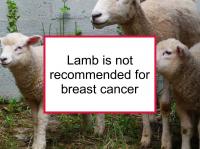Lamb is a good dietary source of protein, B vitamins, and zinc. Lamb also contains high levels of conjugated linoleic acid (CLA) and stearate, both of which have been shown to induce breast cancer cell death. However, the potentially favorable effects of these components appear to be overwhelmed by lamb's less beneficial characteristics.
These include a high level of saturated fat and the carcinogenic effects of naturally-occurring lamb compounds, lamb additives and lamb preparation methods. Diets high in red meat or well-done red meat have been linked in various population studies to higher risks of non-Hodgkin's lymphoma and cancers of the oral cavity, throat, esophagus, lung, stomach, pancreas, liver, colon, rectum, endometrium and prostate.
Breast cancer-related effects of eating lamb
Most population studies combine lamb with other red meat intake when evaluating the influence of lamb consumption on breast cancer risk and some groups of people seldom eat lamb. The following studies specifically included lamb, either as part of red meat consumption, or separately:
- A prospective study that was designed to investigate the relationship between post-diagnosis diet and survival after breast cancer reported that women in the highest compared to the lowest fifth of intake of saturated fat intake had a significantly higher risk of dying from any cause. Saturated fats are found primarily in meats and dairy foods (fatty beef, lamb, pork, poultry with skin, lard, whole milk, cream, butter, cheese) and baked and fried foods containing palm oil, palm kernel oil or coconut oil. Results were similar for risk of dying specifically from breast cancer, however they did not reach statistical significance.
- A Chinese retrospective case-control study designed to investigate the relationship between dietary patterns and risk of breast cancer found that a diet characterized by high consumption of vegetables, fruit, soy, milk, poultry, and fish and low consumption of refined grains, red meat, and pickles was associated with reduced risk of breast cancer.
- A Uruguayan study which analyzed 39 food groups to determine association with ductal breast cancer reported that a dietary pattern that included lamb was associated with increased breast cancer risk.
- A study that included 52,158 postmenopausal women reported that, comparing the fifth to the first quintile, red meat, the heterocyclic amine (HCA) 2-amino-3,8-dimethylimidazo[4,5-f]quinoxaline, and dietary iron each were associated with increased risk of breast cancer.
- Higher red meat consumption during adolescence by women in the Nurses' Health Study II has been found to be associated with increased risk of premenopausal breast cancer in adulthood.
- A UK study found that both pre- and postmenopausal women who consumed the most meat (including red meat) had the highest risk of breast cancer.
A number of factors may account for the findings of increased breast cancer risk:
- The U.S. lamb industry uses zeranol, a non-steroidal compound with estrogenic activity, as a growth promoter. Zeranol has been found to stimulate human breast cancer cell growth and proliferation. Other growth promoters (mostly hormones) that are routinely administered to lamb are also suspected to contribute to breast cancer risk.
- Irradiation of lamb, which is widespread in the U.S., has been found to result in the formation of alkylcyclobutanones, which have been shown to have mutagenic and tumor promoting activities.
- Some of the HCAs formed in very well-done lamb and in lamb drippings are known human carcinogens that have been shown to have potent estrogenic activity, inducing activation of estrogen-regulated genes, proliferation of estrogen-dependent cells and up-regulation of progesterone receptor.
- While iron deficiency anemia is a serious condition to be avoided, the contribution of significant iron in the diet as a result of regularly consuming lamb could be detrimental for some women. Lamb contains more iron than pork, but less than beef. Iron depletion has been shown to lead to significant inhibition of breast cancer cell growth in the laboratory. Relatively high levels of iron in benign breast tissue was found in one prospective study to be associated with an increase in risk of subsequent breast cancer. Other studies have found high levels of iron in the blood to be associated with increased breast cancer risk. Excess iron can interfere with the treatment effects of the chemotherapy drugs doxorubicin and cisplatin.
Additional comments
Most U.S. consumers never eat mutton (the meat of grown sheep), which has a strong flavor compared to lamb. The majority of lambs consumed in the U.S. are grown in Texas, California, Wyoming, Colorado or South Dakota and processed in Colorado, Iowa, Michigan or New Jersey. Lambs are normally "finished" (grown to maturity) in feedlots. Colorado produces the most organic lambs and sheep. However, over 40 percent of U.S. lamb and mutton is imported from Australia and New Zealand.
If lamb is to be consumed, it makes sense to buy grass-fed organic lamb to avoid eating irradiated, growth hormone-treated meat from soy- or corn-fed animals. Grass-fed lamb has a more favorable fatty acid content, with a higher proportion of omega-3 fatty acids. Note that the organic label does not necessarily mean free range or grass fed. The primary requirements for lamb to be labeled organic is that the animals are raised without the use of antibiotics and growth hormones and that their feed (grain, hay, pellets) must be organically grown. Although most New Zealand land is grass-fed, lamb grown for export to the U.S. may be corn fed (to satisfy U.S. consumer tastes).
Well-done and flame-broiled lamb is not recommended. Fat drippings and grill residue scrapings contain particularly high levels of HCAs and should be discarded.
Sources of information provided in this webpage
The information above, which is updated continually as new research becomes available, has been developed based solely on the results of academic studies. Clicking on any of the underlined terms will take you to its tag or webpage, which contain more extensive information.
Below are links to 20 recent studies concerning lamb, mutton and their components. For a more complete list of studies, please click on lamb.
